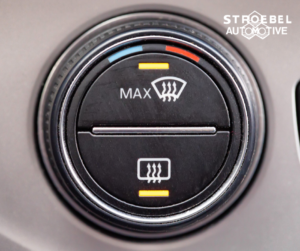Have you ever been stuck in your car on a cold day and wondered, “Is my defroster sending heat to the front of my car?” Or maybe you’ve been confused because some cars have vents in the back, and others don’t. Or maybe your defroster doesn’t work the way it should.
A car’s defroster directs the airflow from the heaters toward the windshield and side windows.
The defroster is the system from your heater that directs air from the heater toward the windshield and side windows. When you switch on your defroster in cold weather, warm air flows out of vents near those windows to clear them of fog and frost before they build up enough to obscure visibility or cause ice buildup.
The layout of your vents can affect how effectively your vehicle’s heating works.
In order for your vehicle’s heating system to work efficiently, it’s important to understand how the vents are positioned in the cabin. The most obvious factor is whether or not there are any working vents at all.
Another thing you need to consider is how far apart from each other (and from you) these vents are located; this will affect how quickly heat reaches different areas of your body and whether there are hot spots where one area gets more heated than another. If they’re too far away from each other, then they won’t provide sufficient coverage across all parts of the car and may leave certain areas completely cold while others become uncomfortably warm or even hot enough for discomfort during extended periods of use.
Also, check what direction each individual duct faces. Is it aimed directly at your body? Or does it point toward a window?
A good heating system is like having an extra blanket built right into your car!
A good heating system is like having an extra blanket built right into your car! It keeps you warm in the winter and cool in the summer, but it can be tricky to operate properly. Some cars have a heater-ventilation system that uses a single blower for both purposes–heating and ventilation–and this type of car has a control valve in the heater circuit so that you can turn off the air conditioning and use only the blower for heating. The best way to check if this is happening properly is to get under your hood (or open up an engine compartment) while running at idle speed with no load on your engine; if there’s no noticeable airflow coming out from under your hood, then there may be something wrong with either your fan or blower motor or else there might be debris blocking its path through its housing.
If everything looks OK when checking things out from underneath, try turning off all fans except one at full blast (this must include an electric fan mounted above or next to the radiator core). If there is still no noticeable change, suspect faulty wiring between switches/relays, etc.
Signs that you might need to replace your defroster include a lack of heat from the vents and very warm air blowing out of them.
If you’re noticing a lack of heat coming from the vents or if very little warm air is blowing out of them, it’s likely time to replace your defroster. Another sign that your defroster may be broken is visible condensation around the rearview mirror or windshield when you turn on the defroster. This indicates that water is trapped inside and must be removed before it damages any electrical components in your vehicle.
You may also see visible condensation around the rearview mirror or windshield when you turn on the defroster, which indicates that this unit may also be defective.
If your car’s heating system is working properly, but you’re still finding it difficult to see through your windshield in winter weather conditions, a few things could be causing this problem:
If you notice that your defroster isn’t putting out enough heat, take a look at how it directs airflow and make sure all vents are open so that there’s no blockage between them
Check the system for leaks and repair them as necessary. The same goes for wiring damage; if any wires are exposed or damaged, replace them with new ones before reconnecting everything to ensure proper operation of the whole unit again. Finally, check the fan motor for damage and replace it as necessary if needed–this can happen after years of use or even during installation if something goes wrong during installation (i.e., dropping an expensive component on concrete).
Contact Stroebell Automotive for your maintenance today!


